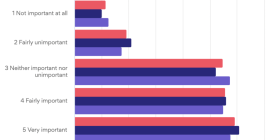Purpose
The purpose of a business stems further than the amount of profit that it aims to make but exploring the ‘why’ of its existence. By creating meaningful engagement between the brand and the consumer, purpose-driven leaders will assist this way of operating to create better economic opportunities for everyone.
Brand philosophy can be seen in the company’s corporate social responsibility and sustainability.
“Corporate social responsibility refers to companies taking responsibility for their impact on society” (Londrigan, 2018)
The mission and vision of a brand can be found within the brand’s mission statement which states the aims and values of a company or organization. This is an integral part of branding since this may be what draws the target group of consumers who share the same values and goals about their own impact on the environment and society. Additionally, every company should have an established CSR that reflects the brand’s philosophy.
A brand’s purpose is often implemented throughout the process rather than solely at the start or the end. By not having an established or re-established purpose, brands tend to miss out on the social and ethical impacts they have on society. With a transparent supply chain and positive employee treatment, TOMS has been able to connect better with its consumers. (Londrigan, 2018)
There is no reason why brands should communicate their purpose other than that there is no other alternative. Gen Z expects companies to establish clear stances on social or political issues and by using social media, they can shape corporate behavior. (Curry, 2020) The blurred line between branded and unbranded content means that it can be easier for brands to speak and act on social and ethical issues. by creating this opportunity for both brands and potential consumers, there is greater transparency.
Digital campfires are smaller social media platforms where people can participate in shared experiences and connect to micro-communities. (Wilson, 2021) Tiktok is a digital platform with 100 million monthly active users. Through a user’s activity, the algorithm will match them with more of the same content and thus join a digital campfire for micro-communities. There is also an opportunity for large-scale global campaigns allowing brands to be more creative with their advertising, targeting both macro and micro-communities and ultimately creating a relationship and better consumer interaction.
Brands can use the Brand Advocacy Map to help navigate through potentially sensitive cultural and social terrain. (Curry, 2020) On two axes a brand can measure its credibility and depth of engagement. To make long-term equity within the company, they must invest time and money to make both internal and external changes.

Londrigan, M.P., & Jenkins, J.M. (2018) “Corporate Social Responsibility and Sustainability.” Page 42
Londrigan, M.P., & Jenkins, J.M. (2018) “Corporate Social Responsibility and Sustainability.” Page 43
Curry, L. (2020) How Brands Can Follow Through on the Values They’re Selling Available at: https://hbr.org/2020/08/how-brands-can-follow-through-on-the-values-theyre-selling (Accessed: 4 November 2022)
Wilson, S. (2021) Where Brands Are Reaching Gen Z Available at: https://hbr.org/2021/03/where-brands-are-reaching-gen-z (Accessed: 3 November 2022)
Curry, L. (2020) How Brands Can Follow Through on the Values They’re Selling Available at: https://hbr.org/2020/08/how-brands-can-follow-through-on-the-values-theyre-selling (Accessed: 4 November 2022)

